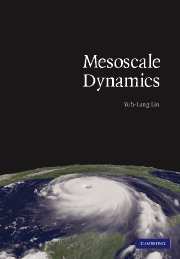Book contents
- Frontmatter
- Contents
- Preface
- 1 Overview
- 2 Governing equations for mesoscale motions
- 3 Basic wave dynamics
- 4 Mesoscale wave generation and maintenance
- 5 Orographically forced flows
- 6 Thermally forced flows
- 7 Mesoscale instabilities
- 8 Isolated convective storms
- 9 Mesoscale convective systems
- 10 Dynamics of fronts and jet streaks
- 11 Dynamics of orographic precipitation
- 12 Basic numerical methods
- 13 Numerical modeling of geophysical fluid systems
- 14 Parameterizations of physical processes
- Appendices
- Index
- References
1 - Overview
Published online by Cambridge University Press: 15 December 2009
- Frontmatter
- Contents
- Preface
- 1 Overview
- 2 Governing equations for mesoscale motions
- 3 Basic wave dynamics
- 4 Mesoscale wave generation and maintenance
- 5 Orographically forced flows
- 6 Thermally forced flows
- 7 Mesoscale instabilities
- 8 Isolated convective storms
- 9 Mesoscale convective systems
- 10 Dynamics of fronts and jet streaks
- 11 Dynamics of orographic precipitation
- 12 Basic numerical methods
- 13 Numerical modeling of geophysical fluid systems
- 14 Parameterizations of physical processes
- Appendices
- Index
- References
Summary
Introduction
Mesoscale dynamics uses a dynamical approach for the study of atmospheric phenomena with a horizontal scale ranging approximately from 2 to 2000 km. These mesoscale phenomena include, but are not limited to, thunderstorms, squall lines, supercells, mesoscale convective complexes, inertia-gravity waves, mountain waves, low-level jets, density currents, land/sea breezes, heat island circulations, clear air turbulence, jet streaks, and fronts. Mesoscale dynamics may be viewed as a combined discipline of dynamic meteorology and mesoscale meteorology. From the dynamical perspective, mesoscale concerns processes with timescales ranging from the buoyancy oscillation (2π/N, where N is the buoyancy (Brunt–Vaisala) frequency) to a pendulum day (2π/f, where f is the Coriolis parameter), encompassing deep moist convection and the full spectrum of inertia-gravity waves but stopping short of synoptic-scale phenomena which have Rossby numbers less than 1. The Rossby number is defined as U/fL, where U is the basic wind speed and L the horizontal scale of the disturbance associated with the phenomenon. The study concerned with the analysis and prediction of large-scale weather phenomena, based on the use of meteorological data obtained simultaneously over the standard observational network, is called synoptic meteorology. Synoptic-scale phenomena include, but are not limited to, extratropical and tropical cyclones, fronts, jet streams, and baroclinic waves. The synoptic scale is also referred to as the large scale, macroscale, or cyclone scale in the literature and in this textbook. Traditionally, these scales have been loosely used or defined.
- Type
- Chapter
- Information
- Mesoscale Dynamics , pp. 1 - 11Publisher: Cambridge University PressPrint publication year: 2007
References
- 1
- Cited by



